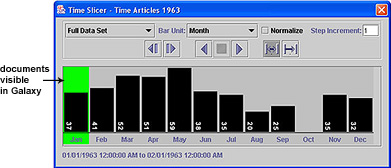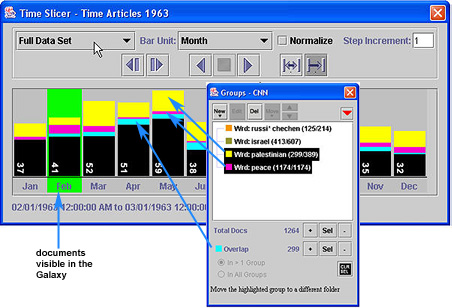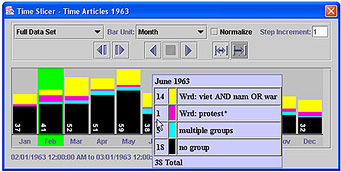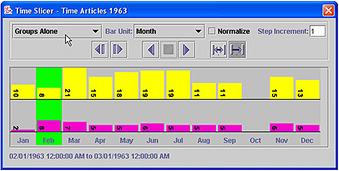Data Sets
Overview
Creating New
--ASCII Text
--XML
--Google Harvest
--Web Harvest
Settings
--Fields
--Stopwords
--Stopmajors
--Punctuation Rules
Editing
Merging
Exporting
Importing
Subsetting
Visualizations
Galaxy
--Basics
--Outliers
ThemeView
Settings
Tools
Document Viewer
Gist
Groups
--Basics
--Evidence Panel
Major Terms
Queries
Print
Probe
Time Slicer
About version 2.2
Overview
Known issues
![]()
Time Slicer

Data Sets whose documents contain a date field can be analyzed using the Time Slicer. The Time Slicer facilitates a study of the relationship between document topics and time, and allows you to track those changes. When the Time Slicer is open, instead of showing all documents in the data set, both the Galaxy and the ThemeView™ show only documents that are contained within the time period highlighted in the Time Slicer’s histogram. This can be one or more than one bar. Notice that there will be an annotation ("Time Filter active") in the upper left hand corner of the Galaxy when the Time Slicer is open.
In the image above, no Groups are visible, because none are highlighted in the Groups tool. To understand how Groups are represented in the Time Slicer see Groups in the Time Slicer.
Accessing the Time Slicer
| Click the Time Slicer button on the toolbar, or | |
| From the Windows menu, choose Time Slicer |
Time Slicer controls
| What | Why | How |
| Manually step through the slices, forwards or backwards | Display documents in the desired time period only. | Use the Step buttons, or Click on the time slice and drag it. See Changing the slice by clicking and dragging |
| Set the length of time represented by each bar or "slice". | Control which time periods' documents are displayed together. | Set the Bar Unit by selecting a unit (second, minute, hour, day, week, month, or year) from the dropdown menu. |
| (Play and Step setting) Set how you step through slices. |
Ability to sample at regular intervals. For example, set the Bar Unit to Day, and the Step Increment to "7". | Set the Step Increment by typing a positive integer in the text box to the right of Step Increment. During Play or Step, the time slice will move the number of bars specified. The default is "1". |
| Keep the width of the slice the same. | Show each period's documents in turn, without combining them with adjacent periods'. | Click the |
| Add each succeeding step to the width of the slice | Show total accumulation of documents over time. | Click the Grow button |
| Play through slices automatically, forwards or backwards | Get overview of trends in types of documents found. | Use the Play buttons. |

To see a Group in the Time Slicer
Highlight the Group in the Groups Tool. The proportion of the bar representing
documents in the highlighted Group will be drawn in the Group color. Notice
that the order of groups in the Time Slicer is the same as that in the
Groups Tool. The view when Full Data Set is selected is as above.
To see information about groups
Hold the cursor over the slice of interest. A popup window appears
with the highlighted group names and statistics.

You may also display the groups separately. Select Groups Alone from the dropdown menu at the window's top left.

Changing the Slice by clicking and dragging
To change the location of the slice, in other words, to jump from one time period's documents to another's, click anywhere in the area of the label for the time period you want to see.
If you have changed the width of the slice, the width will revert to 1.
To change the width of the slice
Move the cursor near the edge you want to move. the cursor changes
to a green doubleheaded arrow. Click and drag out that side as far as
desired, then release the mouse button.
